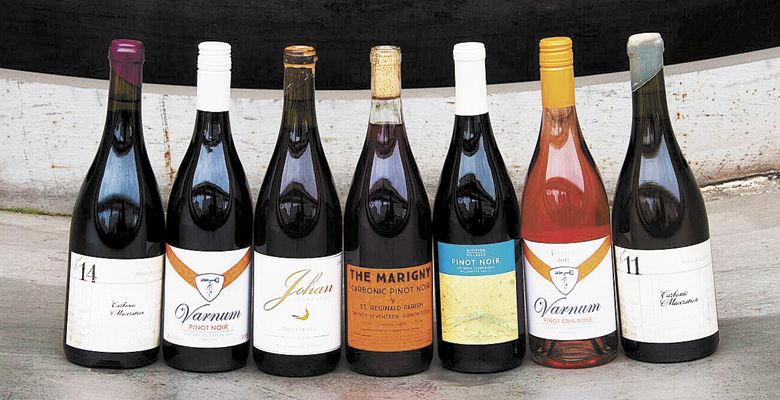Inside Out
Fermentation within the grape makes for fun, fruity wine
The Oregon wine industry straddles a fine line, keeping one foot firmly planted in tradition and the other in innovation. Some avant-garde Oregon winemakers are experimenting with carbonic maceration, a style traditionally used for Beaujolais Nouveau — Gamay Noir known for its swift fall release — in Beaujolais, France, but adapting the technique to work best in their wine cellars and with Oregon fruit.
Sterling Whitted of Holden Wines says, “I like bright, fresh wines and love Beajuolais, where this process is intrinsic to the style. I keep it in my brain as a way to make a more vin de soif style, an approachable wine, as well as something that can mitigate potential problems.” Whitted describes how this technique worked to his advantage in 2017, where fruit he acquired from Southern Oregon had the potential for flaws from smoke taint. Carbonic maceration was used as a way to prevent that from being a problem, keeping the vibrant fruit flavors front and center.
Carbonic maceration is wine geek speak for a process where intact bunches of grapes are placed into a sealed container with carbon dioxide (typically, dry ice or gas). The initial fermentation, taking place inside each single ripe grape, occurs without the influence of other microorganisms (yeast). The CO2 permeates the grape’s skin, stimulating fermentation within each berry, breaking down the skin at a cellular level and extracting the phenolic flavors and structure before the fruit undergoes the normal fermentation process (with yeast). The resulting wines are typically light in color, fruity, approachable, less-tannic and often ready for early release.
Carbonic wines are sometimes called “bubble gum wines,” since flavors of sweet raspberry and strawberry practically burst from the glass. That term also implies playful wines, not overly complex and just downright fruity. Thomas Monroe of Division Wine Company clarifies, “Carbonic maceration results in lower tannins, and uniquely light red fruit, almost like freeze-dried fruits. They’re aromatic wines that are usually simpler, but very tasty and unique when young.”
Discovering carbonic maceration was Andy Young of St. Reginald Parish’s first hint that technique can mean more to the final product than varietal. Outside vine age and appropriate soil type, Young says what happens in the cellar creates a wine with true personality. He says carbonic maceration results in his wines revealing more energy and depth. He describes placing a great deal of trust into the process, but asserts, “The results speak for themselves. The wines are more approachable in their youth, though I have several cuvées with extended stem times for the express purpose of building structure for aging.”
Partial carbonic maceration has become increasingly common in Oregon wineries. Winemakers like Day Wines, Varnum Vintners and Domaine Roy et Fils all utilize this technique with various wines. For example, Cyler Varnum’s Pinot Noir is made with 25-percent whole cluster at the bottom of the fermenter to create an untouched separate layer remaining mostly carbonic throughout primary fermentation, adding structure to the wine. He finds the partial carbonic incorporates aromatics, complexity and mouthfeel.
When considering whole-cluster Pinot fermentations, Dan Rinke of Johan Vineyards concluded carbonic maceration was occuring in the very bottoms of his fermenters. In 2009, he started making a skin-fermented Drueskall Pinot Gris with great success. Two years later he began using 50-percent carbonic maceration with the wine.
In a perfect carbonic ferment, all oxygen is displaced with CO2, and the grapes, which are still totally intact after about two weeks, start to get fizzy. Rinke says, “You bite into a grape, and it’s like Pop Rocks inside.” As for the results of carbonic on a finished wine? Rinke says, “For the Drueskall, the part that is non-carbonic, or is destemmed and fermented like a red wine, is super tannic and a bit harsh. The carbonic helps balance the wine, soften the palate, and provide cinnamon and rose petals aromatics.”
Winemaker Chad Stock of Minimus Wines explains how carbonic maceration can be useful in cold vintages, where capturing fruit aromatics prove challenging. “We tend to have high amounts of malic acid in the fruit from some of the northern AVAs. In addition to sugar, malic acid is partially consumed during carbonic maceration, so this technique can reduce the taste of lactic acid as well as enhance fruit aromas.” Stock finds this method highly effective for grapes from Southern Oregon AVAs, where wines like Syrah and Mourvèdre from the Applegate Valley AVA tend to be heavier and benefit from more perfume, freshness and reduced extraction.
When asked how carbonic wine ages, Stock says, “Personally, I’m a fan of using the method to make prettier, less-extracted wines from intense red grape varieties. Because I work this way, I can still end up with a carbonic macerated wine made from Syrah that has more structure and acid than a traditional fermented Pinot noir, for example, which could allow my Syrah to age just as long, or longer, than most Pinot Noir.”











